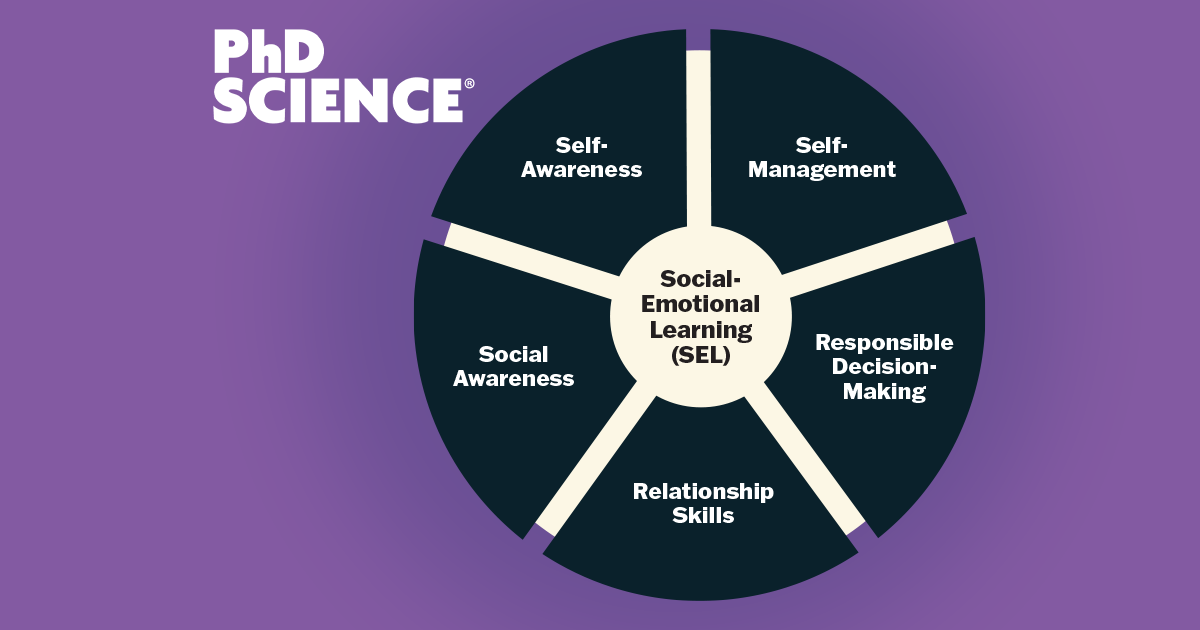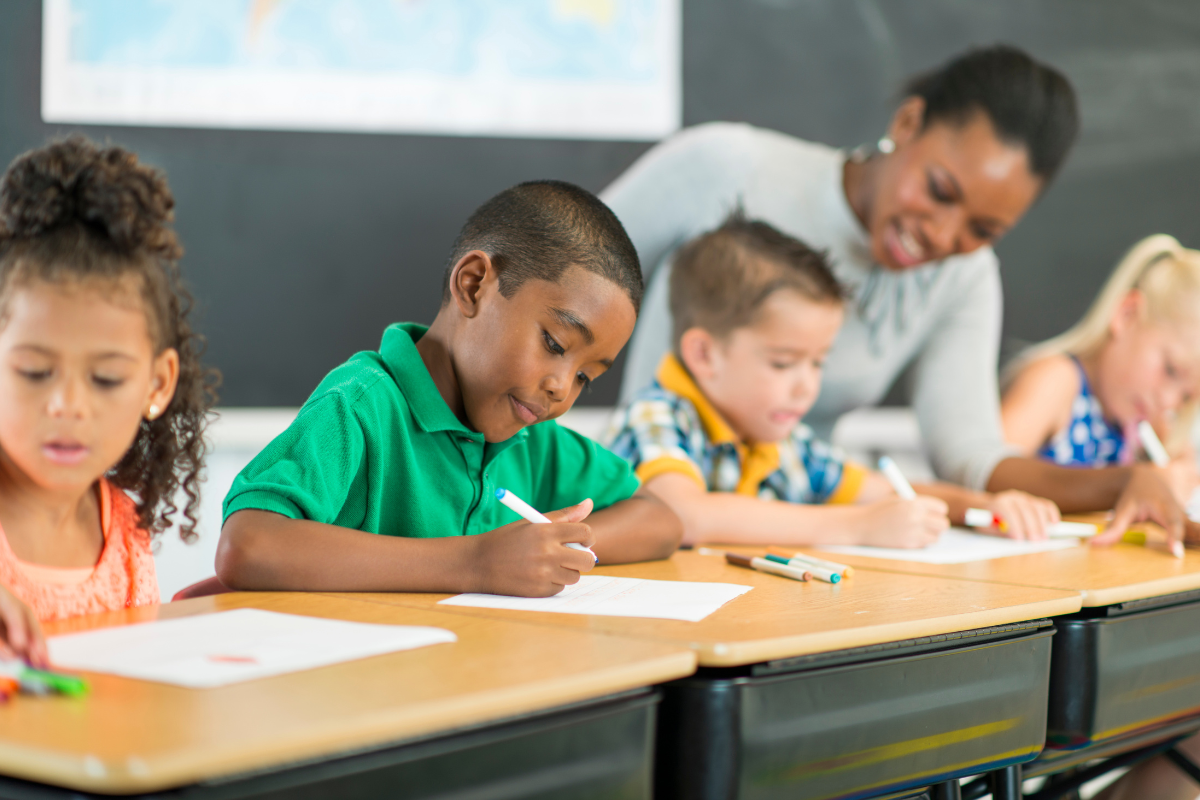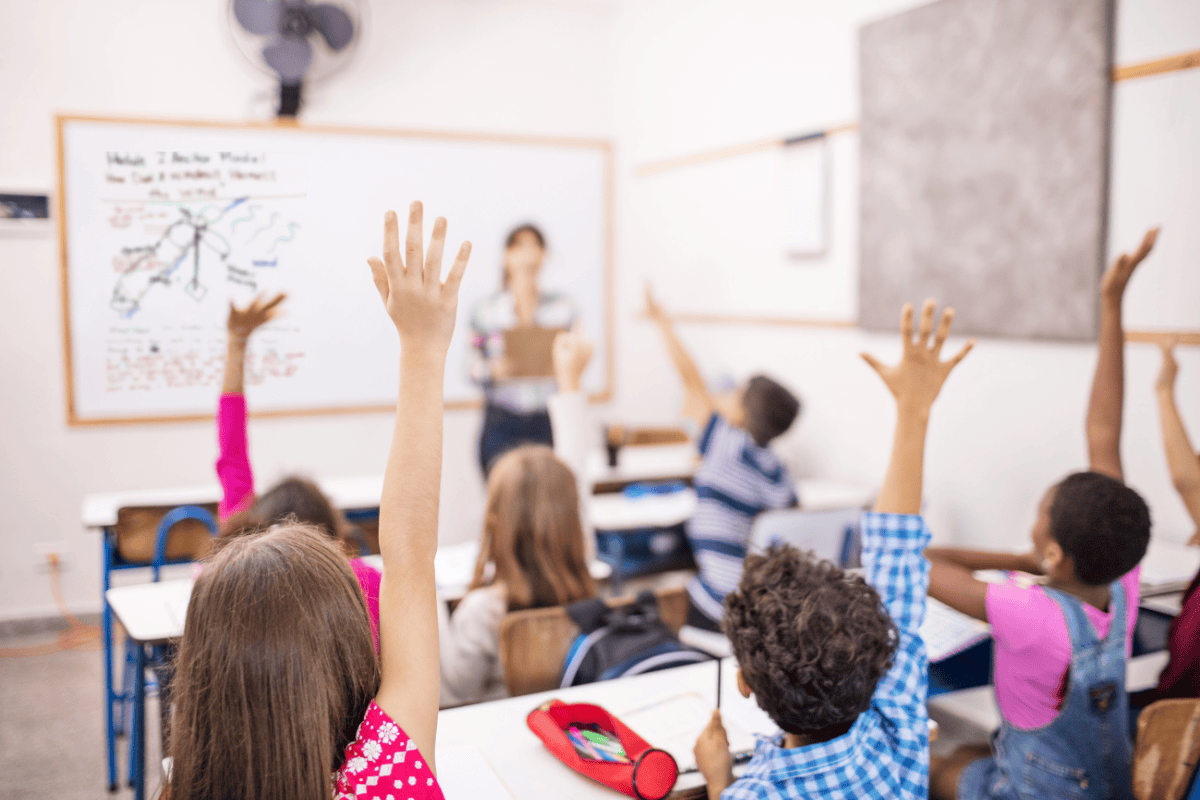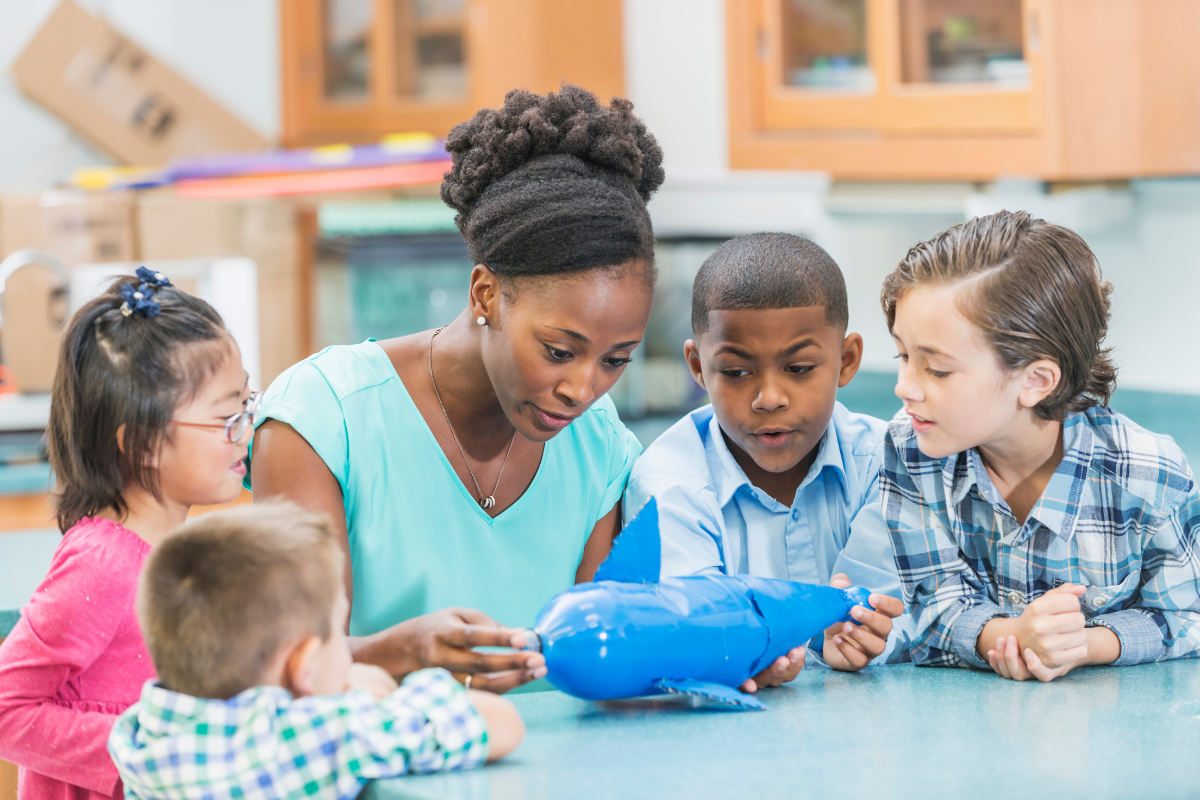Posted in: Aha! Blog > PhD Science > Science SEL > The CASEL Framework in Action: How PhD Science® Integrates Social, Emotional, and Academic Learning
How does PhD Science® integrate social-emotional learning (SEL) with science instruction?
Students’ social and emotional well-being is intimately connected to their academic success. When students feel a sense of belonging and significance in their classroom and school environments, they have more autonomy over their learning.1 Research demonstrates that students succeed when social-emotional needs are met and struggle when they are not.2 Academic success requires students to develop key social-emotional skills, such as communicating effectively with others, organizing and managing tasks, and recovering from setbacks and failures.3 These skills help students develop the productive disposition necessary for learning science. Schools must accordingly foster students’ social-emotional development in seamless integration with academic learning.4
As a student-centered curriculum, PhD Science implicitly and explicitly supports students’ social-emotional well-being and development. PhD Science was designed with the research-based understanding that social, emotional, and academic learning are interconnected multidirectionally. Not only do students perform better academically when their social and emotional needs are met, but engaging in academic learning with joy in a supportive, safe classroom helps them feel competent, significant, and successful.5
PhD Science is inquiry based. As such, it taps students’ natural curiosity and helps them use that curiosity to figure out how the world works. Their curiosity sparks their independent thinking and helps them to be owners of their learning. In PhD Science, students analyze data and information, look at evidence, and apply reasoning to information they’ve been provided or to their own observations. They then synthesize that information and devise explanations to answer questions they’ve helped craft during the module. To drive their own learning, students must develop and practice multiple SEL competencies, including self awareness, self-management, and responsible decision-making.
Another key benefit of student-driven, inquiry-based learning in PhD Science is that it encourages students to work and think collaboratively. Collaborative work builds students’ relationship skills and fosters academic learning: Having done the work of analyzing information, data, and facts independently, students then bring their understanding to the whole class.
Throughout PhD Science, students first develop their own thinking and understanding, and then they have regular opportunities to engage in collaborative work with their classmates through activities like respectful peer-to-peer discourse, small group investigations, and the revising of anchor models. This collaborative work leads to the synthesis of ideas from all students, and active listening to peers’ reasoning, claims, and evidence, so students arrive at the best solution together. Along the way, students’ individual ideas may be challenged when they are presented with new evidence, causing them to reconsider their own thinking. For collaborative thinking and working to be successful, students need to engage in the SEL competencies of self-management, social awareness, and relationship skills.
As a hands-on, student-centered curriculum, PhD Science requires students to be responsible as they engage in investigations. The curriculum puts materials in students’ hands, and they do the investigations themselves. They have the latitude to make their own plans, but they must consider the safety of the materials, including live plants and animals, as well as their own safety and that of their peers. Students must develop an understanding that all science materials must be handled carefully, and the curriculum provides explicit support in this effort. Students must exercise both self-management and responsible decision-making to responsibly carry out investigations.
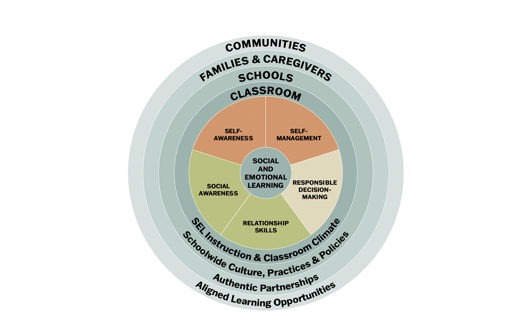
Throughout the curriculum, students have ample opportunity to develop and refine all five social-emotional competencies identified by the Collaborative for Academic, Social, and Emotional Learning6 in a variety of authentic settings while building knowledge about science and the world.
Self-awareness
Students must recognize their own emotions, thoughts, and values as they work individually and collectively in the science classroom. As students are asked to develop questions, models, predictions, and claims individually and in groups, students must also have the self-confidence to recognize their own strengths and limitations as related to the task at hand. Critical components of self-awareness that students develop for successful engagement in science learning include the ability to demonstrate integrity and honesty and to assume a growth mindset—as students learn more, they may need to alter their initial models or hypotheses.
Self-management
As they work individually and collectively to develop questions, models, hypotheses, and explanations, students must manage their own emotions, thoughts, and behaviors to accomplish the task at hand. To engage in group discussion, students must organize and convey their own thoughts while controlling emotions. When students conduct investigations, they must plan and organize their investigation work, manage their behavior, exhibit self-discipline, participate congenially in group work, maintain a safe environment during investigations, and take the initiative when needed. Successful group work requires personal and collective agency, organization, and self-discipline.
Responsible decision-making
To create a safe environment for themselves and their peers when working on science activities, students must develop and exercise strong judgment. Understanding ethical standards and safety concerns and evaluating the benefits and consequences of various actions for personal, social, and collective well-being is at the heart of science practice. In addition, students nurture their curiosity and open-mindedness, learning how to make a reasoned judgment after analyzing information, data, and facts that help them identify solutions.
Relationship skills
To collaboratively develop models, fair tests, experiments, investigations, and hypotheses, students must establish and maintain healthy and supportive relationships and effectively navigate settings with diverse individuals and groups who bring their own experiences and knowledge to the work. To be successful, students must communicate clearly, listen actively, work collaboratively, and negotiate conflict constructively, seeking or offering help or leadership when needed.
Social awareness
PhD Science was designed to help students develop and cultivate an ability to understand and empathize with others, whether they are in the classroom or on the other side of the world. Carefully selected anchor phenomena broaden students’ experiences and provide opportunities for contributions from students who might have experience with a particular phenomenon or can connect that phenomenon to a personal experience. As they see how phenomena near and far are connected to their own lives, students develop a broader social context, learn to appreciate others’ strengths and points of view, and come to understand the influences of organizations and systems on behavior.
The curriculum as a whole is designed to foster student discourse and support students in taking risks. It introduces and consistently uses specific structures and routines that help students feel connected to one another and to their learning; they feel safe taking the academic risks needed to be successful in the classroom. In each lesson, students interact with the teacher, the content, and one another in a variety of ways, including through instructional routines such as Chalk Talks, Inside–Outside Circles, Mix and Mingle, and Think–Pair–Share. Beyond the integration of academic and social-emotional skills at individual grade levels, the curriculum is also vertically aligned to foster social-emotional development over time. As the science becomes more complex, so too do the social-emotional expectations. These expectations are embedded in the curriculum’s tasks and routines, such as planning an investigation. Initially, teachers may take the lead in helping students plan an investigation and may guide student conversation.
As students progress through the curriculum, however, they take on more responsibility for planning investigations and completing their work. Investigations incorporate more steps and more demanding materials that require more care, so students must follow stricter safety measures. More complex investigations also require students to measure and record more complex data with greater accuracy. This progression of responsibility in planning and carrying out investigations requires students to exhibit self-awareness and self-management and to engage in responsible decision-making. From their first lesson, students practice and refine their SEL skills while deeply engaging in science.
Research has demonstrated the powerful and lasting effects of integrating academic, social, and emotional learning. Indeed, such integration is key to the success of PhD Science. Students thrive because they have the pedagogical, social, and emotional support needed for rigorous academic learning. A strong foundation in these areas prepares students to succeed in all aspects of life, not just in school.
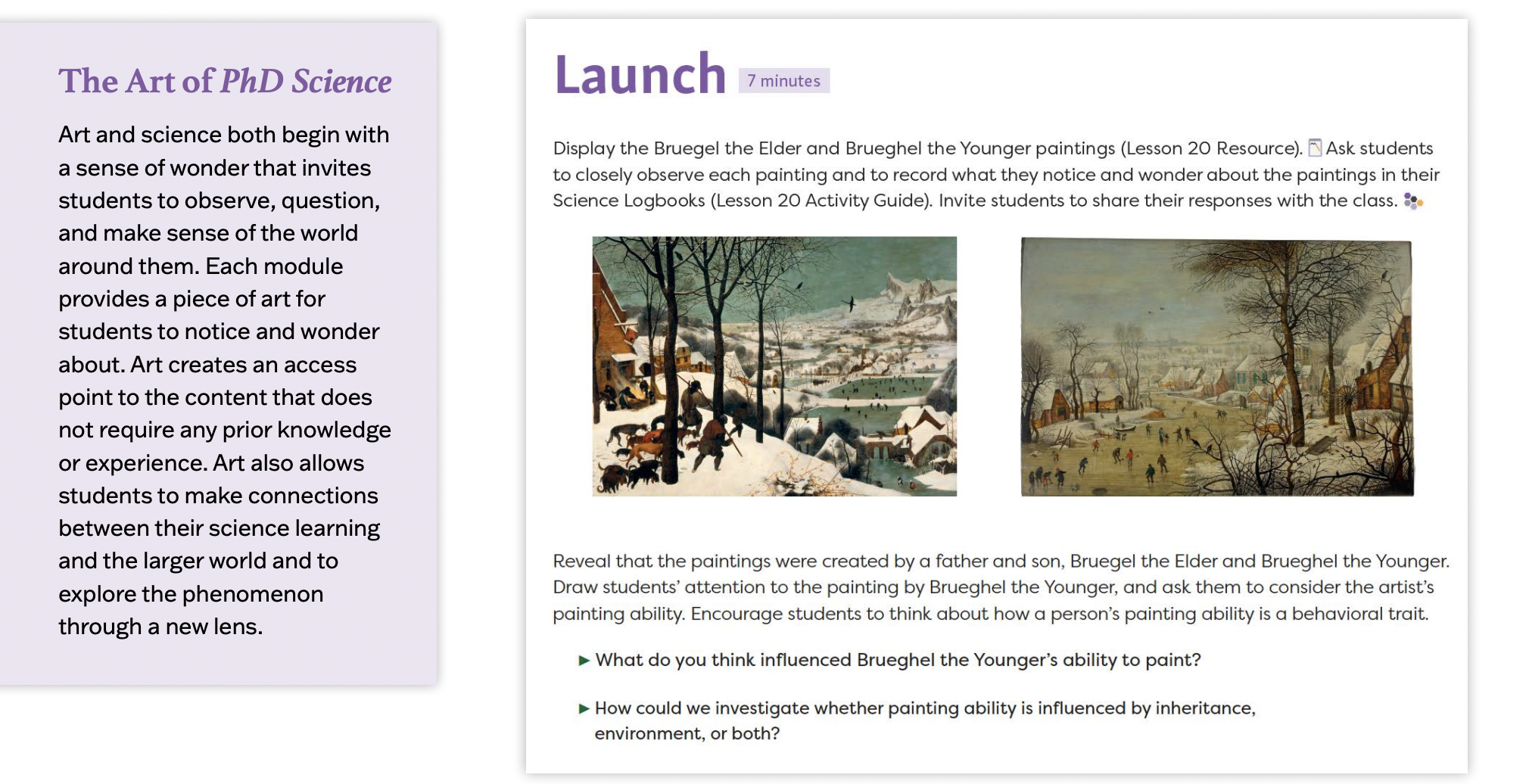
Elaboration: How PhD Science builds SEL
The following table showcases how the components of PhD Science align with SEL competencies.
| PhD Science Module Features | Alignment with SEL Competencies |
| Anchor phenomena The anchor phenomena are rich, multilayered scientific phenomena that motivate instruction throughout the module. At the beginning of each module, students explore the anchor phenomenon and use their background knowledge to develop an initial anchor model to help them understand the anchor phenomenon. |
Social awareness. The anchor phenomenon that drives each module’s learning is designed to help students connect with an authentic real-world experience that they may have no firsthand knowledge of. As they work with the anchor phenomenon, they build their understanding of the perspectives of others who have experienced the phenomenon, and they begin to learn about the diverse cultural contexts in which people use science. Example: In Level 5 Module 3, students learn about Balinese rice farmers and how their traditional methods of rice farming have endured for more than 1,000 years, proving more effective than many modern techniques. The Balinese rice farming anchor phenomenon introduces concepts related to the interactions of Earth’s biosphere, hydrosphere, atmosphere, and geosphere. These ideas can be hard to conceptualize, but the anchor phenomenon shows students tangible examples of these scientific processes and how humans can design sustainable systems by using their understanding of natural processes. |
| Student-generated phenomena Throughout a module, students share related phenomena they have experienced in their lives. By connecting students’ experiences to the phenomena and concepts presented in the module, the curriculum helps teachers gain insight into students’ current knowledge. |
Self-awareness. Students integrate their personal social identities when they connect phenomena they see in their lives to the anchor phenomenon. Making these connections also gives students more control over their learning. Social awareness. As they identify related phenomena, students hear about and learn from the experiences of other students in the classroom. Students can demonstrate empathy and compassion for other students and benefit from being exposed to new experiences. Students also practice sharing their own experiences with the class. Example: In Level 3 Module 1, students learn about the 1900 Galveston hurricane as the anchor phenomenon. Even if students do not live in an area where hurricanes occur, they can connect weather experiences in their own lives, such as tornadoes, earthquakes, and nor’easters to the anchor phenomenon. |
| Anchor model development The anchor model is a class model that students develop together. It is displayed in the classroom so students can refer to and update it throughout the module. By the end of a module, the anchor model reflects students’ explanation of the anchor phenomenon. |
Self-awareness. In developing anchor models, students must advocate for what they think should be included while recognizing the potential limits of their model and considering where it might be improved. (Note: Students create their own anchor models and then use them to contribute ideas to the class anchor model.) Sharing and comparing their individual models to help develop the class anchor model also allows students to notice similarities and differences between their ideas and others’ ideas, which opens them to new information that might change their thinking and improve their understanding. Self-management. Students must manage their thoughts and behaviors as the class works together to develop the anchor model. They need to self-monitor to make sure they contribute appropriately to the collective goal and use planning skills to decide when to share their ideas. They must also have courage to share their contribution to the class to help create the class anchor model. Responsible decision-making. As students work to develop the class anchor model, they can demonstrate curiosity and open-mindedness as they hear their classmates’ ideas. Students are also encouraged to make reasoned judgments as they analyze the information, data, and facts that arise in the course of their module learning and determine how to use them to refine the model. Relationship skills. Students establish and maintain supportive relationships as they work together to build the best model based on current information. Students must clearly communicate their ideas, listen to their classmates, and work collaboratively to solve problems, resolve differences, and support one another in learning. Social awareness. Developing an anchor model requires students to consider the perspectives of others and assess how they may think differently or similarly about the model. Developing a collective anchor model also requires students to be active in the conversation and recognize opportunities to support consensus building throughout the process. Example: In Level 5 Module 2, after students have developed their own model of a mangrove tree ecosystem, they are encouraged to explain to a partner or small group what they included in their model, providing provide evidence as to why they included what they did, and elaborate on the perspective from which they designed the model. By sharing their models of the anchor phenomenon, students can see models from the perspectives of other students and adjust their thinking about their own models, which prepares them well for the development of the class anchor model. Students work collaboratively to develop the class model, deciding what to include where and why based on evidence. |
| Driving question board development The driving question board is a tool that organizes student questions about the anchor phenomenon. Work with the board increases student engagement, highlights connections between concepts, and records the enduring knowledge students acquire throughout the module. |
Self-management. Students must demonstrate personal agency when they share a question to contribute to the collective goals of developing the driving question board and guiding class learning. Students must identify whether their question aligns with one already on the board and take the initiative to place it in the appropriate location on the board. Students must also collaborate reasonably as they work together to develop the Focus Question categories. Responsible decision-making. Students demonstrate curiosity and open-mindedness by developing a question to share, and they make reasoned judgments as they listen to other students’ questions and decide where their own question aligns with those already on the board. Relationship skills. After students form their own questions about the phenomenon, they communicate those questions to others and practice teamwork and collaborative problem-solving by categorizing all of their questions as a group. Once the questions are categorized, students collaboratively investigate them to build knowledge and answer the module’s Essential Question. This collaborative thinking session also helps students develop positive relationships with one another as they work collectively to define the Focus Questions for the driving question board and constructively resolve any conflicts that may arise during their work. Students may also show leadership by taking the lead in developing the Focus Questions or by standing up for the ideas of others. Social awareness. Students take in the perspectives of others when they hear other students’ driving questions and relate them to their own. Students show concern for others’ feelings by seeking to understand others’ questions instead of criticizing them. Example: In Level 3 Module 4, students are asked to refer to their questions in their notice and wonder charts and choose the question they are most interested in answering. After one student reads a question and places it on the driving question board, students are asked who has a related question to read and place on the board to form categories of related questions. After all students have their questions on the board, the class works together to develop a Focus Question for each category and adds the Focus Questions to the driving question board. To successfully develop the driving question board, students have to exhibit self-management and autonomy, listen to their peers, decide where their question should go, and then work collaboratively and communicate effectively to develop the Focus Questions. |
| Collaborative conversations An instructional routine such as collaborative conversations is a classroom procedure that supports the development of content knowledge and academic skills in an engaging and active way. These routines increase student engagement and make students’ thinking and learning visible. Collaborative conversation routines include Fishbowl, Inside–Outside Circles, Mix and Mingle, Question Corners, Response Techniques, Socratic Seminars, Think–Pair–Share, Value LineUp, Vote–Discuss–Revote, and Whip Around. |
Self-awareness. Through Think–Pair–Share partner activities and Stop and Jot individual activities, students are asked to bring their own thinking and experiences to the lessons, sharing them first with a partner and then with the class. Relationship skills. Throughout a module, students gather evidence to answer questions they have about what they are learning. They use this evidence to make arguments and to justify to their peers why their position is valid. In doing so and in observing others doing the same, they come to understand that one’s position may change based on the evidence presented. These experiences help students practice relationship and speaking and listening skills. Responsible decision-making. In Socratic Seminars, students have the opportunity to make a reasoned judgment after analyzing and synthesizing data, information, and facts. When students are asked to discuss the Essential Question, they must synthesize all the work they’ve done in the module to arrive at an explanation of the anchor phenomenon. Example: In Level 4 Module 1, students engage in a Socratic Seminar to discuss the Essential Question: How did the Grand Canyon’s features form? For a successful discussion, students must incorporate their new science knowledge and draw on the anchor models for evidence and support. Students must regulate themselves during the discussion while listening actively and communicating clearly and effectively. Students largely moderate themselves, responding to one another directly with minimal teacher facilitation. |
| Investigations Students engage in the practice of planning and carrying out investigations in nearly every module of PhD Science. As students engage in phenomenon-based instruction, the investigations they plan and carry out are key to building deep understanding of scientific concepts. |
Self-management. Students regularly work in small groups and must manage themselves in a way that serves the group. Students must demonstrate self-discipline to ensure personal and collective safety, and they must practice self-motivation to contribute fairly to the assignment so other group members do not do all the work. Students also set personal and collective goals to complete the assignment and must use planning and organizational skills to successfully coordinate all the required steps of the assignment. Relationship skills. Successful small group work requires students to establish and maintain healthy and supportive relationships and to effectively navigate the assignment with diverse individuals. Students must communicate clearly, listen actively, and work collaboratively to complete the assignments safely and on time. Small group work helps students develop their ability to collaborate to solve problems and to negotiate conflict constructively. For example, they may need to settle differences of opinion about the assignment or about how best to develop fair tests. Social awareness. Working successfully as a small group requires students to understand others’ perspectives and recognize each person’s strengths as they all work toward a shared goal. In addition to identifying roles and responsibilities for the small group activity, students contribute different ideas and skills to complete the task successfully. Example: In Level 4 Module 2, students work together to design a fair test investigation of the impact of energy on speed. They use a ball bearing, a ruler, and a textbook to demonstrate energy transfer. To successfully design and execute this fair test, students have to work collaboratively, communicate effectively, consider each other’s viewpoints, and agree on an investigation plan. Team members must also successfully execute their individual assignments during the fair test, collecting valid data to analyze and use to draw conclusions based on evidence. |
| Engineering Challenges Engineering Challenges allow students to apply their conceptual knowledge to solve real-world problems through the process of engineering. |
Self-awareness. In Engineering Challenges, students focus on designing solutions and then evaluating those solutions to determine how they might be improved. As part of this process, students practice the growth mindset skills of embracing challenges and believing effort is the path to mastery as they create one solution and then iterate that solution, adjusting it to increase its effectiveness. They learn to question their original design and assumptions when presented with new information. Self-management. Students practice sharing and receiving input and feedback to improve the work they do toward completing the Engineering Challenge. Social awareness. As students design their models and solutions, they can draw on others’ strengths and learn from one another. Depending on the challenge, some students may have additional background knowledge or contextual information they can apply to the design solution. Students must consider each other’s perspectives, especially as they relate to the development of the design solution, to produce a viable solution that addresses the challenge presented. Example: In Level 4 Module 1, students participate in an Engineering Challenge in which they consider how people can reduce damage related to erosion. For this challenge, students add a house to a stream table environment and use an engineering design process to modify the area around the house to protect the house from erosion. They then test the effectiveness of their solution with simulated rainfall. |
Broader SEL impact of PhD Science
Family and Community Engagement
PhD Science helps strengthen family and community engagement by offering the following resources:
- Family Tip Sheets, which are available in both English and Spanish, describe what students are learning and how families can support their learning (e.g., talking about science, watching science videos, or visiting community locations such as a museum, park, or zoo).
- Optional homework assignments reinforce learning and connect students’ science learning to their everyday lives, often including ideas to discuss with family members or questions that prompt a simple exploration.
Schoolwide Impact
PhD Science supports SEL development at the whole school through its
- consistent approach to SEL and science integration,
- intentional vertical alignment and increasing sophistication of SEL skills across grades, and
- collaborative approach to professional development that mirrors the structure of the student curriculum and fosters a strong community of adult learners.
Module Example: How PhD Science builds SEL Across Lessons in Level 3 Module 1
Social emotional competencies are at the core of PhD Science. While the discussion above provides examples of opportunities for students to develop and practice SEL throughout the year and across levels, the deeper dive into one module below highlights the SEL opportunities students experience in one module.
The following annotations explain how this module offers students rich opportunities to develop social and emotional learning competencies, including social awareness, self-awareness, self-management, relationship skills, and decision-making skills.
To achieve the module outcomes, students must successfully manage themselves, their work, and their relationships with peers. Teachers provide support and guidance to students while allowing them to take ownership of and direct their own learning.
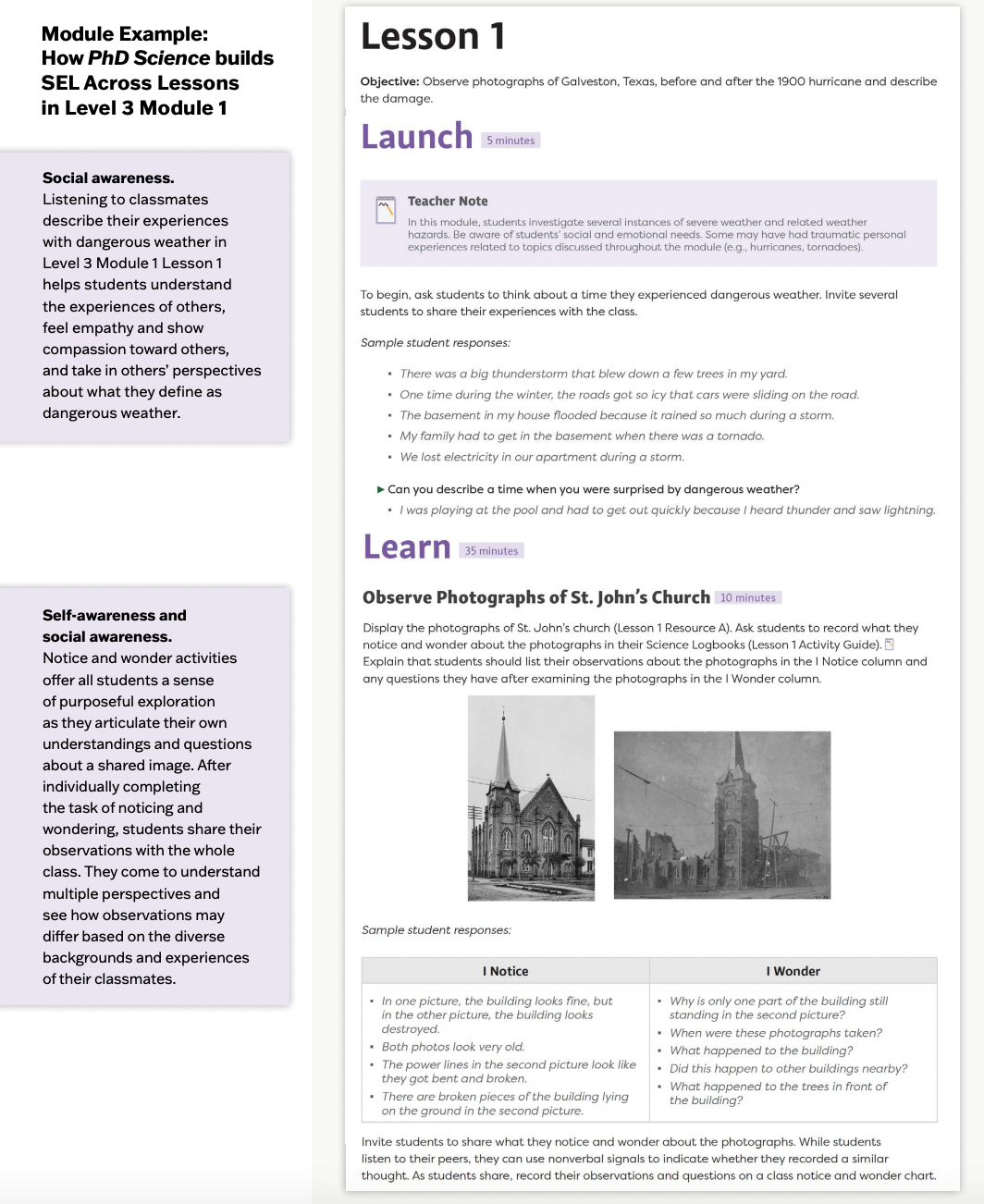



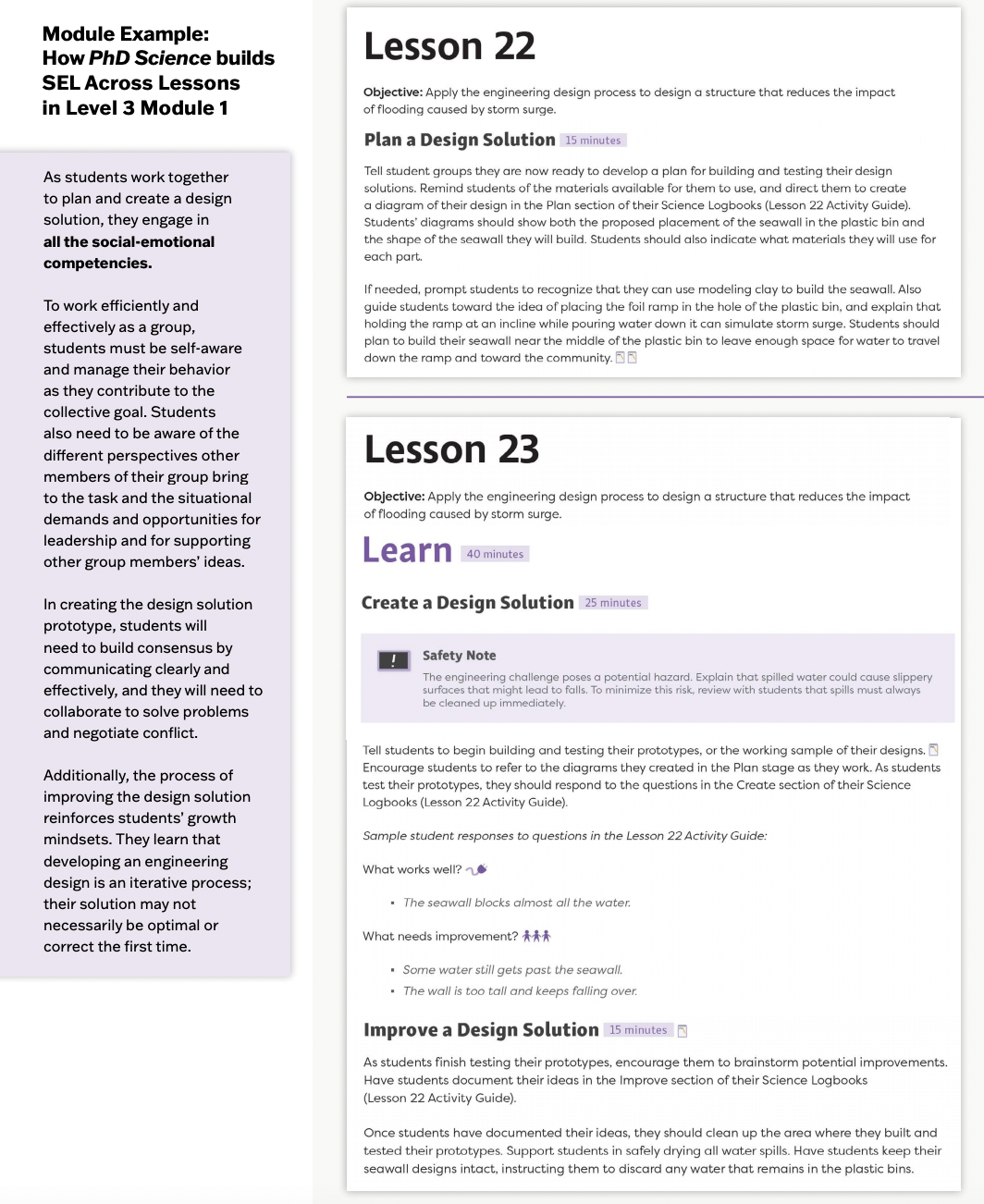
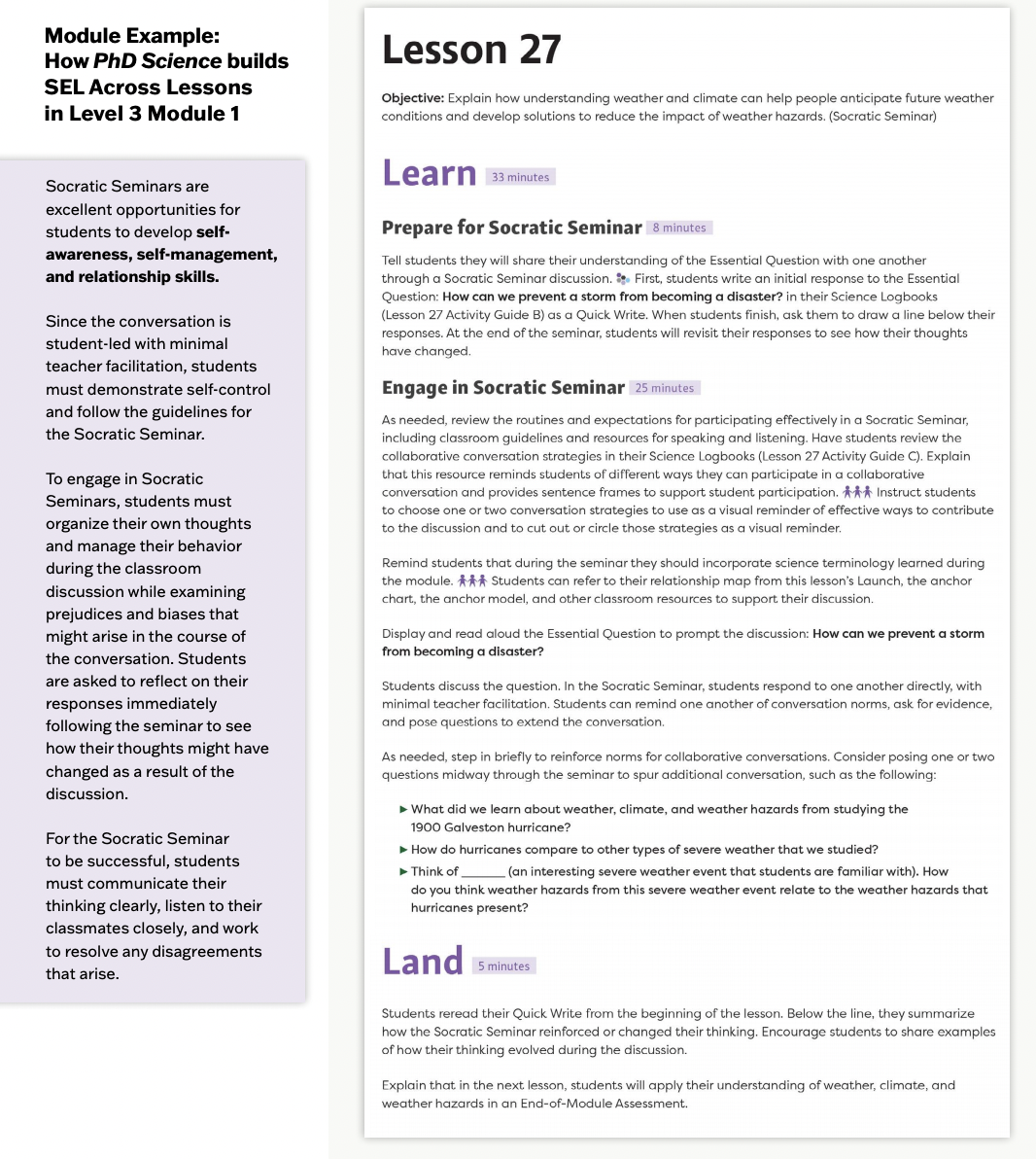
Conclusion
PhD Science seamlessly integrates social-emotional learning, preparing all students to succeed at school and beyond. Students immerse themselves in inquiry-based lessons by asking and answering questions; designing and conducting investigations; arguing from evidence, facts, and data; and building knowledge and enduring understanding of science—all while cultivating their social and emotional learning and skills.
Students interact with their classmates to analyze, design, build, observe, and argue from evidence, building a strong learning community in which they feel safe taking the risks needed to learn. Their learning is collaborative, and their interactions with classmates lead them to deeper knowledge and understanding. The social-emotional skills needed to be successful in the science classroom are the same ones needed for success outside the classroom.
Students who engage in science learning through PhD Science build deep science knowledge and understanding and strong social and emotional skills that will serve them well in all aspects of life.
Special thanks to Lauren Chapalee and Margaret Wilson for their content and editing support.
1Maslow, A. H. Motivation and Personality. New York: Harper & Row, 1970.
2Adolphs, R. “Cognitive Neuroscience of Human Social Behaviour.” Nature Reviews Neuroscience, vol. 4, no. 3, p. 165.
3Payton, J., R. P. Weissberg, J. A. Durlak, A. B. Dymnicki, R. D. Taylor, K. B. Schellinger and M. Pachan. “The Positive Impact of Social and Emotional Learning for Kindergarten to Eighth-Grade Students: Findings from Three Scientific Reviews.” Chicago: Collaborative for Academic, Social, and Emotional Learning, 2008.
4Jones, Stephanie M., and Jennifer Kahn. The Evidence Base for How We Learn: Supporting Students’ Social, Emotional and Academic Development. National Commission on Social, Emotional, and Academic Development, Aspen Institute, 13, September 13, 2017. https://assets.aspeninstitute.org/content/uploads/2017/09/SEAD-Research-Brief-9.12_updated-web.pdf.
5Durlak, J. A., Weissberg, R. P., Dymnicki, A. B., Taylor, R. D., and Schellinger, K. B. “The Impact of Enhancing Students’ Social and Emotional Learning: A Meta-Analysis of School-Based Universal Interventions.” Child Development, vol. 82, no. 1, 2011, pp. 405–32; see also Jones et al.
6Collaborative for Academic, Social, and Emotional Learning (CASEL). “What is SEL?” https://casel.org/what-is-sel/. Accessed 16 March 2021. See also Payton et al.
Download the Article as a Free PDF
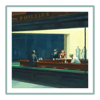
Great Minds
Great Minds PBC is a public benefit corporation and a subsidiary of Great Minds, a nonprofit organization. A group of education leaders founded Great Minds® in 2007 to advocate for a more content-rich, comprehensive education for all children. In pursuit of that mission, Great Minds brings together teachers and scholars to create exemplary instructional materials that provide joyful rigor to learning, spark and reward curiosity, and impart knowledge with equal parts delight.



